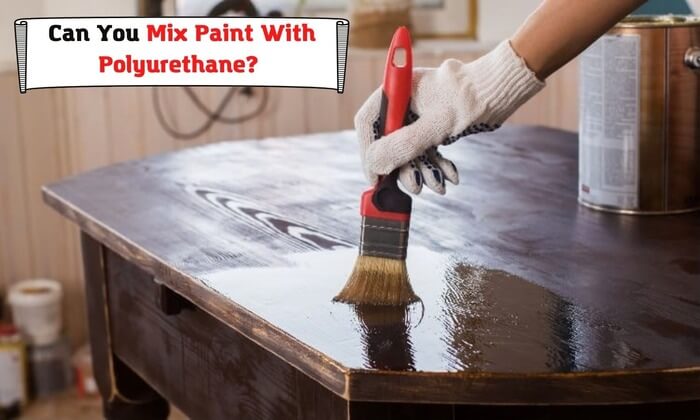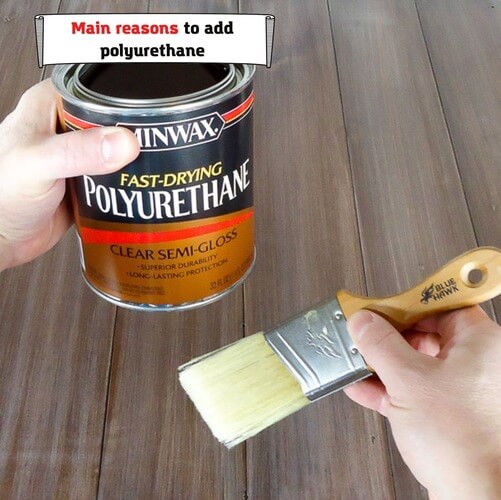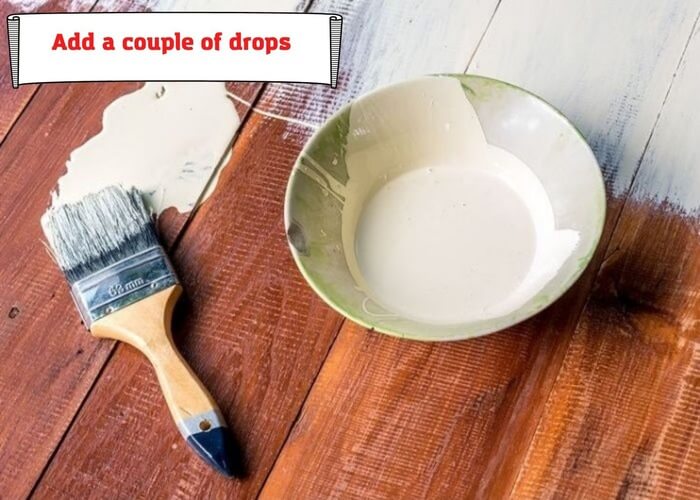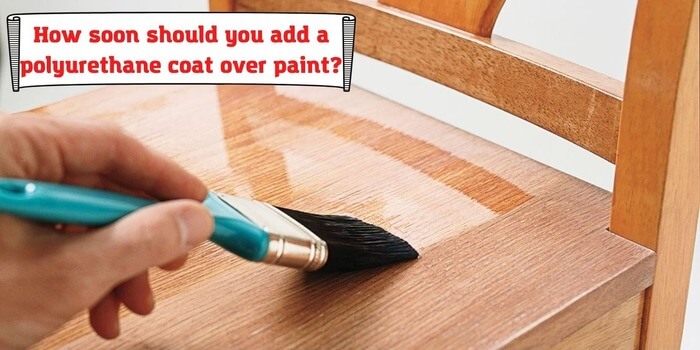
Polyurethane is one of the best top coatings for protecting and sealing wood surfaces. It is reasonably forgiving during application and will always look good whether you roll it, spray it, or brush it. In addition, polyurethane is available in a wide range of lusters, allowing you to fine-tune the final sheen of the finished piece.
The best thing about using polyurethane is that it offers better longevity than paint, foam, rubber, and other applications. Hence, it can save you money and time since it does not require regular replacement or refinishing. A significant challenge when applying polyurethane is whether or not to mix it with paint. Read on to learn more about mixing paint with polyurethane and why it may not be the best idea.
Why is it not a good idea to mix polyurethane and paint?
Even though you can mix water-based varnish with acrylic paint, it is not the best practice. The best strategy here is to apply the paint first and give it sufficient time to cure. Afterward, you can proceed to add the protective polyurethane coats. In addition, certain paint varieties like latex paint don’t mix well when added to polyurethane finishes.
That means mixing polyurethane and paint is not the best approach for tackling your woodworking project. Even though combining these two components may seem more convenient, you should not do it because it can ruin your entire piece.
What will happen if you mix polyurethane with paint?
The core issue of mixing polyurethane with acrylic paint is that you cannot mix oil with water. Water and oil do not mix, and the oil molecules typically shove away the water molecules. It results in the oil clumping together and floating around the water.
That means if you mixed oil-derived polyurethane with water-based paint, then you would get a similar unmixable result. You will get a clumpy, semi-solid mess that is not beneficial in any way.
Can you blend water-based polyurethane with acrylic paint?
If you wish to apply acrylic paint and polyurethane, you should use these two coats separately. It means you must wait for the acrylic paint to cure before you can brush the water-derived polyurethane.
Nevertheless, if you are using water-based acrylic paint, adding a few drops into the water-derived polyurethane before the application is possible. That is mainly done to ensure that the final product does not have a gray, unappealing finish, and it is primarily recommended when using darker paints.
Also, another critical fact worth remembering here is that mixing flat paints with polyurethane will not add a glossy effect to the finished product. Instead, if you are interested in getting a nice sheen or polished finish, then it is better to use a shiny paint product at the start.
Reasons to add polyurethane varnish over acrylic paint

Some paints perform better than others. Thus, when selecting your paint options for your project, there are usually several things to keep in mind. Here are some great reasons why it is best to add a few coats of polyurethane over acrylic paint:
- Achieve a smoother finish: Even though polyurethane is not necessarily completely smooth, it will offer your project a better, smoother finish than acrylic paint only.
- Brighten the surface: Most acrylic paints have a dull, dry, and dark look. You can instantly enhance your project and brighten the aesthetics by adding a clear polyurethane coat that will remain shiny for a long time.
Can you add a polyurethane coat over glossy paint?
Yes, polyurethane can be applied over any high gloss painted surface as soon as the area is completely cured. Polyurethane is quite versatile, and it can be used on all varieties of paint, ranging from semi-gloss and high-gloss paints to chalk paint, acrylic paint, and even latex paint. Make sure you clean the surface with a dry cloth, and then apply at least two or three coats of polyurethane.
What is the right way of applying polyurethane varnish over paint?
The process of applying polyurethane varnish over paint differs from how you would use it over the surface of the wood. Hence, you must be more mindful when dealing with a painted surface. That is because you are more likely to see streaks and blemishes when you apply polyurethane over paint rather than over wood.
Below is a simple guideline that you can follow to apply polyurethane varnish over a painted surface.
Ensure the paint has completely dried
An important thing to remember is that if you add polyurethane over wet paint, you will likely end up wiping the damp paint off, creating unappealing results. Visually, paint can often trick your vision, and it is difficult to determine whether the paint is dry or wet. The solution is to wait as long as possible and if you plan on touching the area to check, ensure to test an inconspicuous spot first.
Clean the painted surface
Polyurethane typically offers a transparent or clear finish, which means that anything on the surface will be visible on the varnish coat. That said, you must wipe or clean the surface to get rid of debris and dust that may have mixed into your paint. Always use a dry cloth when wiping and avoid using cleaning products during this stage as they may affect the adhesion of the polyurethane coat.
Light sanding
Use a 300-grit or higher sanding sponge and remove an unnecessary texture on the painted area. Try not to scratch the paint during sanding.
Add a couple of drops of paint into the polyurethane

While this step may seem like a controversial tip, it is common among woodworking professionals. You should add a couple of paint drops into the polyurethane before application. It will help you get a better finish and eliminate that unappealing gray look, particularly when applying polyurethane over darker paints.
It is critical that you strictly mix a few drops of water-based acrylic paint with water-based polyurethane and reciprocally with the oil-based versions. You should never add oil-based acrylic paint into water-derived polyurethane as it cannot mix properly, which will ruin your finish. Hence, you should disregard this step if you are using opposite varieties of polyurethane and paint.
Apply the first coat of polyurethane
There are various polyurethane application methods available, depending on your needs. They include wiping, spraying, or using a traditional brush. Spraying has been shown to offer the best results if you want to get a smooth finish after applying poly over paint.
Depending on which paint you used for the base coat, you can apply at least two or four polyurethane coats. If using durable paint, you will only need two coats of polyurethane, and if not, it makes sense to apply more polyurethane coats. Lightly sand between the coats with a fine sanding sponge to eliminate dust particles that may cause blemishes.
Give it sufficient drying time
After applying several coats of polyurethane, give the piece sufficient time to dry. For instance, you can leave it overnight and inspect it the following day. If possible, give it at least 24 hours before you can use the piece to ensure the polyurethane layer gets harder to minimize scratching.
How will you know if the paint is completely cured or dry?
An easy way to check if your paint has completely dried up is to touch the surface in an inconspicuous site. Dry paint is not tacky or sticky. If your finger leaves a mark or indentation, you should give the paint more time to cure.
It is crucial that you only apply the first polyurethane varnish coat once the paint is dry and fully cured. Or else the necessary cleaning and light sanding processes will destroy the color or damage the underlying wood.
How soon should you add a polyurethane coat over paint?

Your first coat of polyurethane should be at least one to three days after painting. That way, you can be confident that the underlying paint has dried up completely to prevent complications. You can create more resilient and better-looking surfaces if you wait longer before adding the polyurethane.
What factors affect paint curing and drying time?
- Temperature: The optimal paint drying temperature is around 70 to 78 degrees Fahrenheit
- Ventilation: Proper ventilation ensures faster drying times and also helps to eliminate paint fumes
- Humidity: Excess moisture and humidity can increase the drying time, and it may cause bubbles and other imperfections
- Paint type: Different paint varieties cure at varying rates. For instance, while latex dries in around 4 hours, oil-based paints can take up to 8 hours, while chalk paint only needs 30 minutes to dry completely.
- Wood type: Certain wood varieties like rosewood and aromatic cedar wood have high chemical concentrations that can affect paint adhesion
Conclusion
Polyurethane can help you create a fantastic-looking smooth finish when applied over paint. Besides enhancing the aesthetics, polyurethane also protects the paint and offers improved durability and resistance from scratches. However, the critical thing to remember is to wait for the paint to dry up and cure before applying the polyurethane.
- Shellac Over Mineral Oil – Possible? We’ve Conducted Experiments - January 29, 2022
- Mixing Primer with Texture. And Some Mistakes You Might Make - January 28, 2022
- Acrylic Enamel Reducer Substitute. Safe Testing And Proper Application - January 22, 2022



